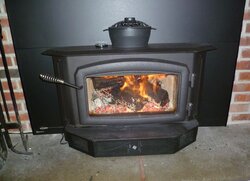- Nov 11, 2012
- 45
Hi all, thanks for all your advice with helping me choose an insert. I ended up going with the Regency i2400. It's been a few weeks since it's been installed and I thought I'd post a pic and ask a few questions while I'm at it.
First off, I really like this insert, looks great and heats up the room nicely (almost too hot most of the time). I wasn't able to get the heat upstairs liked I'd hoped in my raised ranch (insert is on the bottom floor) so now I think it's time for plan B which is to cut a couple of floor vents in to help distribute the heat upstairs. The good thing is the insert is able to maintain the temperature upstairs if I keep the thermostat lowered to 62 so I'm not using any oil during the day. I just wish I could get the temp up to 68 or so.
I was hoping you could help with a few questions I had. This unit has one air control and the manual didn't go into detail on how I should have it positioned while in use. It just said when it's pulled out it allows more air and pushed in less air (obvious, I know).
Once I get the insert going I'm thinking I should push it in to cut the air down to have it burn longer, is this the right thing to do? Sometimes when I close it I hear sort of a howling sound so I have to open it up till it goes away, is this normal?
Also, I don't think I'll be getting an IR gun but I do have a stove top magnetic thermometer. From what I've read/heard, the ideal stovetop temp should be 400-600 degrees. No matter how I fill it, have the air control set. etc. I can't seem to get it above 350 degrees on the stovetop thermometer.
I've checked my wood with a moisture meter and it seems pretty dry, around 20-25, some pieces lower. Not sure if I'm operating the insert correctly or if there are any tips you could help out with.
Thanks again for all your help!
First off, I really like this insert, looks great and heats up the room nicely (almost too hot most of the time). I wasn't able to get the heat upstairs liked I'd hoped in my raised ranch (insert is on the bottom floor) so now I think it's time for plan B which is to cut a couple of floor vents in to help distribute the heat upstairs. The good thing is the insert is able to maintain the temperature upstairs if I keep the thermostat lowered to 62 so I'm not using any oil during the day. I just wish I could get the temp up to 68 or so.
I was hoping you could help with a few questions I had. This unit has one air control and the manual didn't go into detail on how I should have it positioned while in use. It just said when it's pulled out it allows more air and pushed in less air (obvious, I know).
Once I get the insert going I'm thinking I should push it in to cut the air down to have it burn longer, is this the right thing to do? Sometimes when I close it I hear sort of a howling sound so I have to open it up till it goes away, is this normal?
Also, I don't think I'll be getting an IR gun but I do have a stove top magnetic thermometer. From what I've read/heard, the ideal stovetop temp should be 400-600 degrees. No matter how I fill it, have the air control set. etc. I can't seem to get it above 350 degrees on the stovetop thermometer.
I've checked my wood with a moisture meter and it seems pretty dry, around 20-25, some pieces lower. Not sure if I'm operating the insert correctly or if there are any tips you could help out with.
Thanks again for all your help!



 Also, it looks like the door comes off for future maintenance in a very intuitive manner, unlike mine, and the latch looks more foolproof.
Also, it looks like the door comes off for future maintenance in a very intuitive manner, unlike mine, and the latch looks more foolproof.